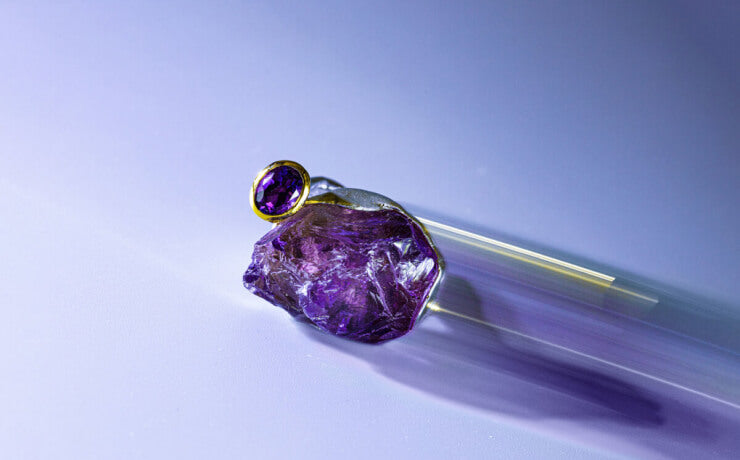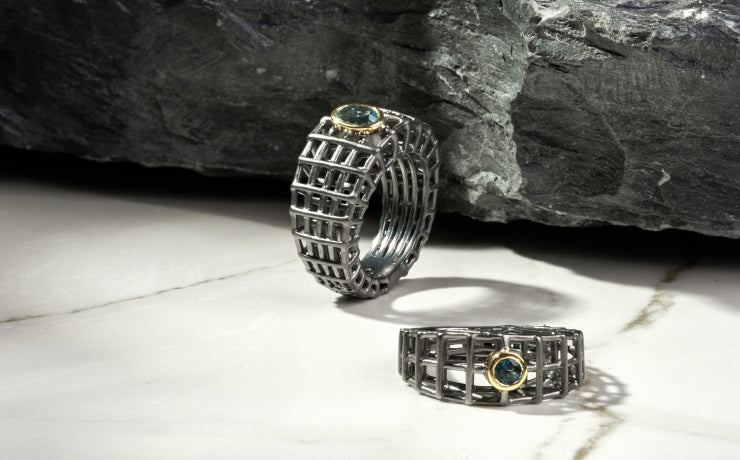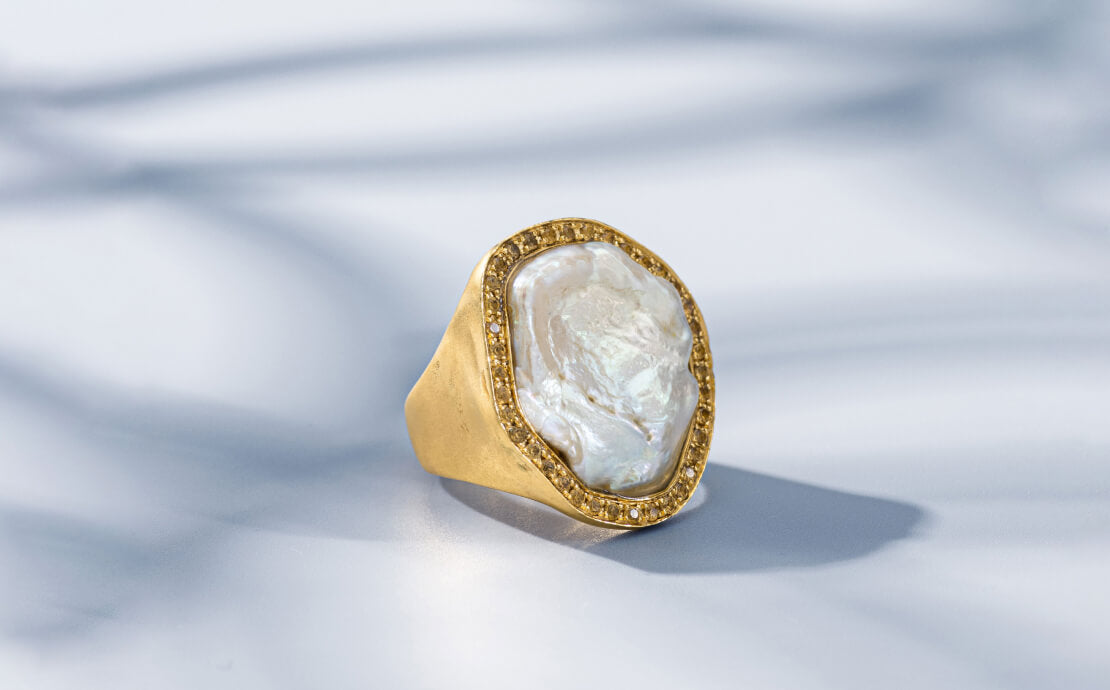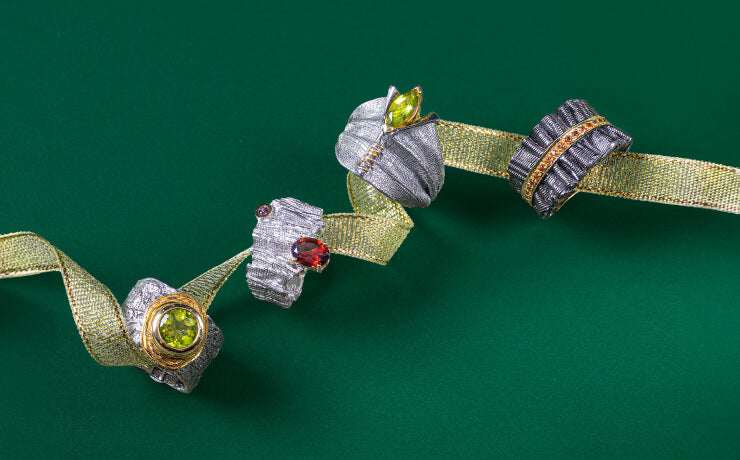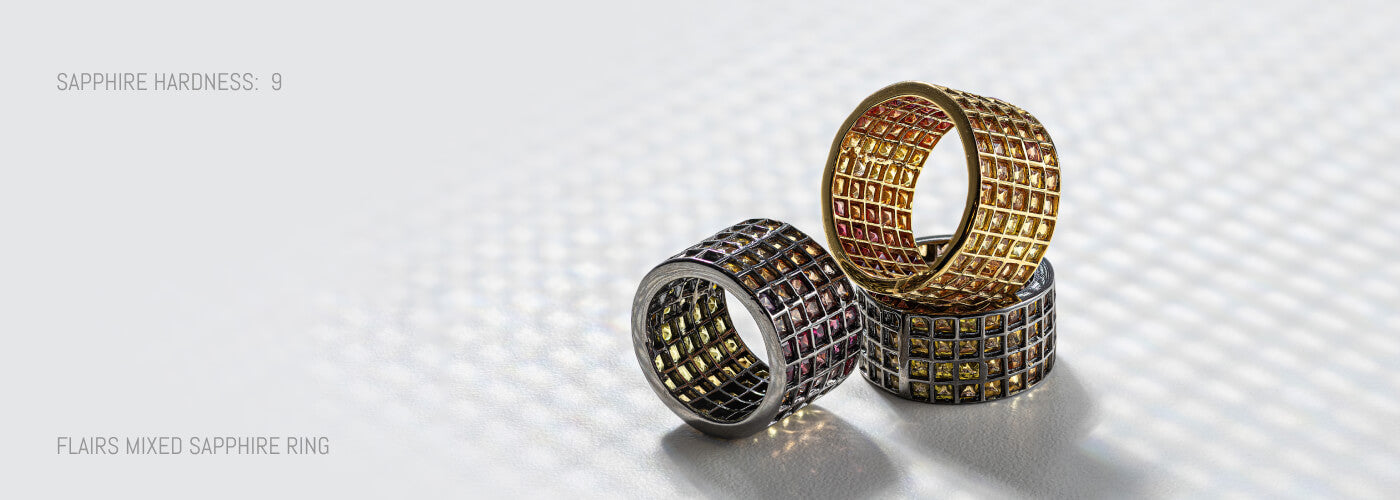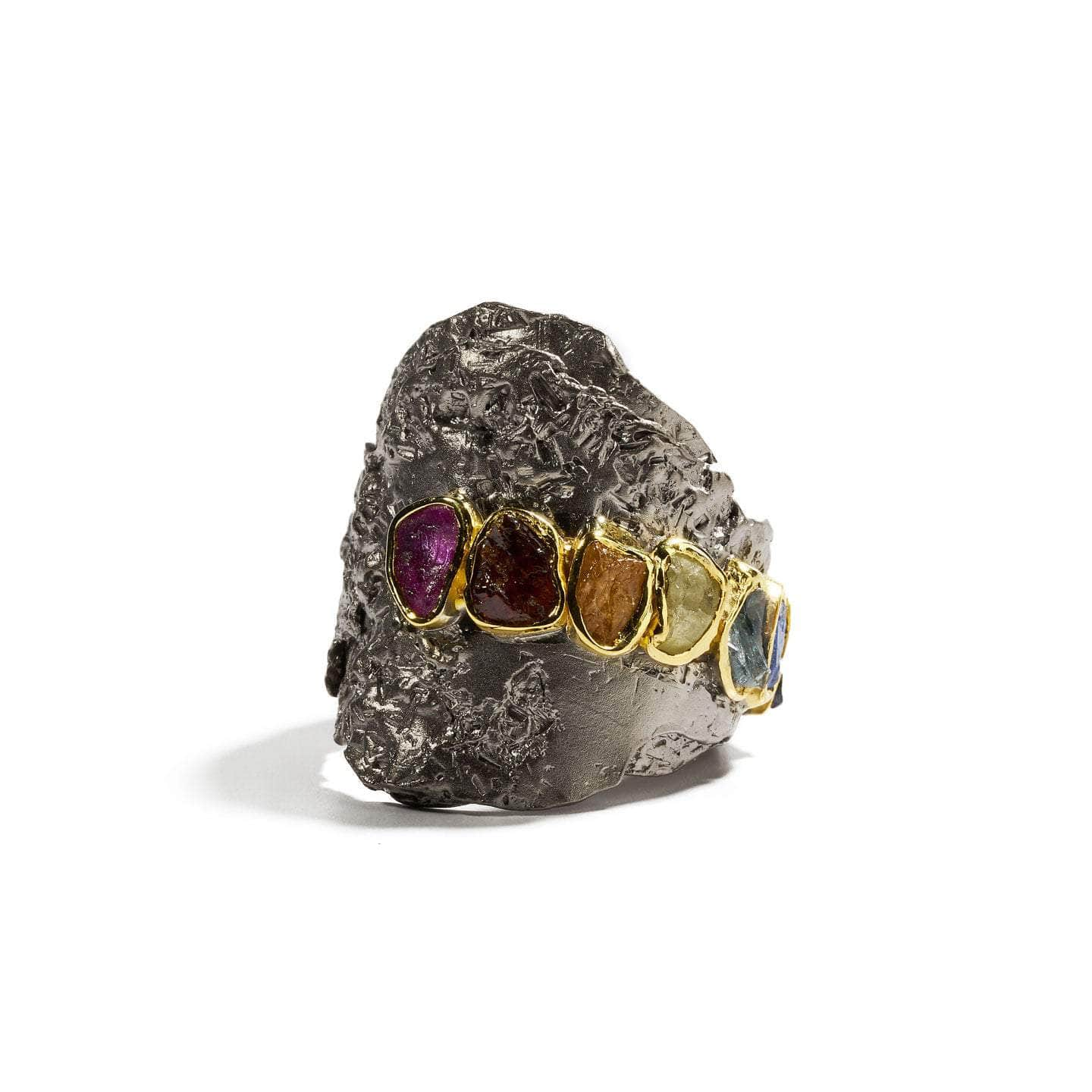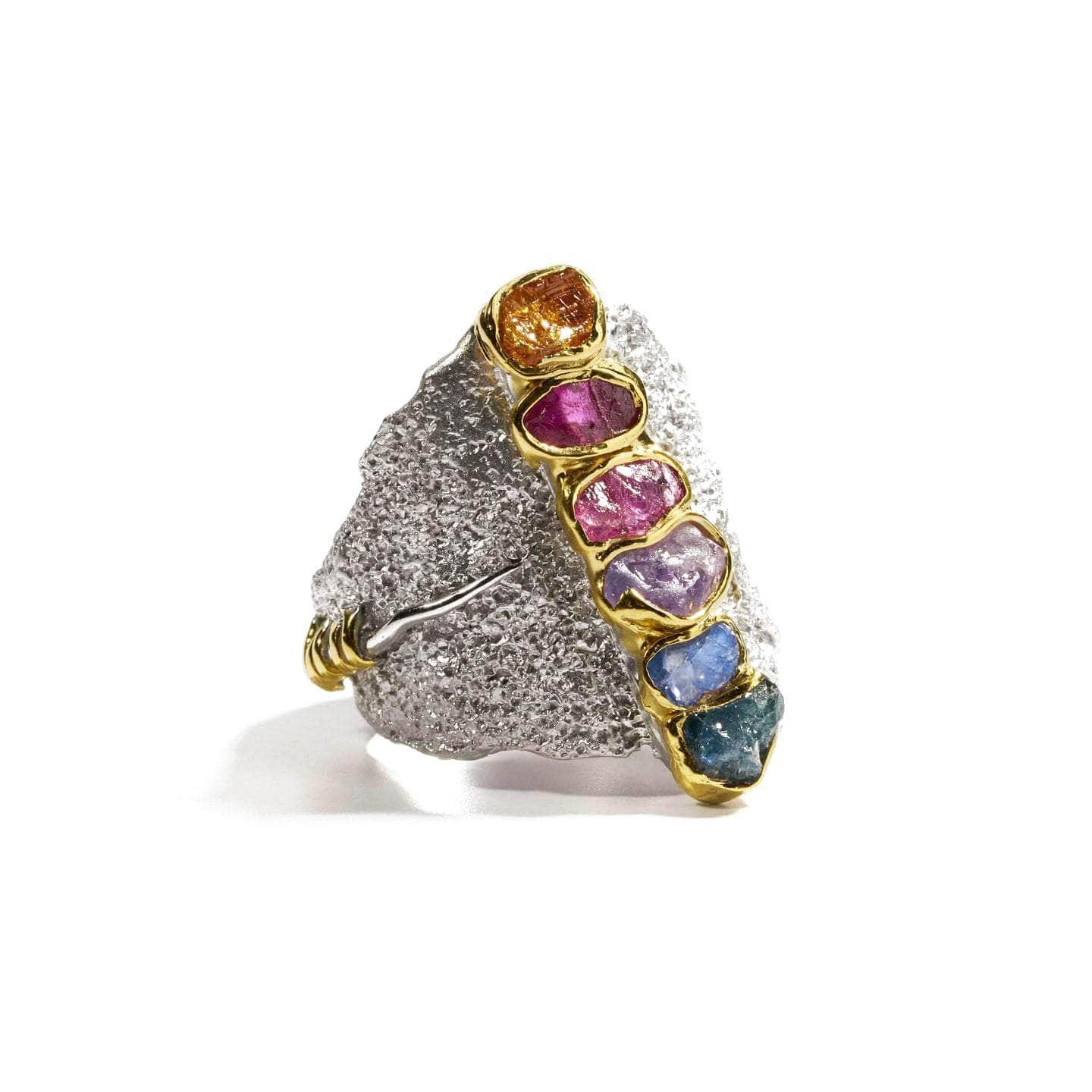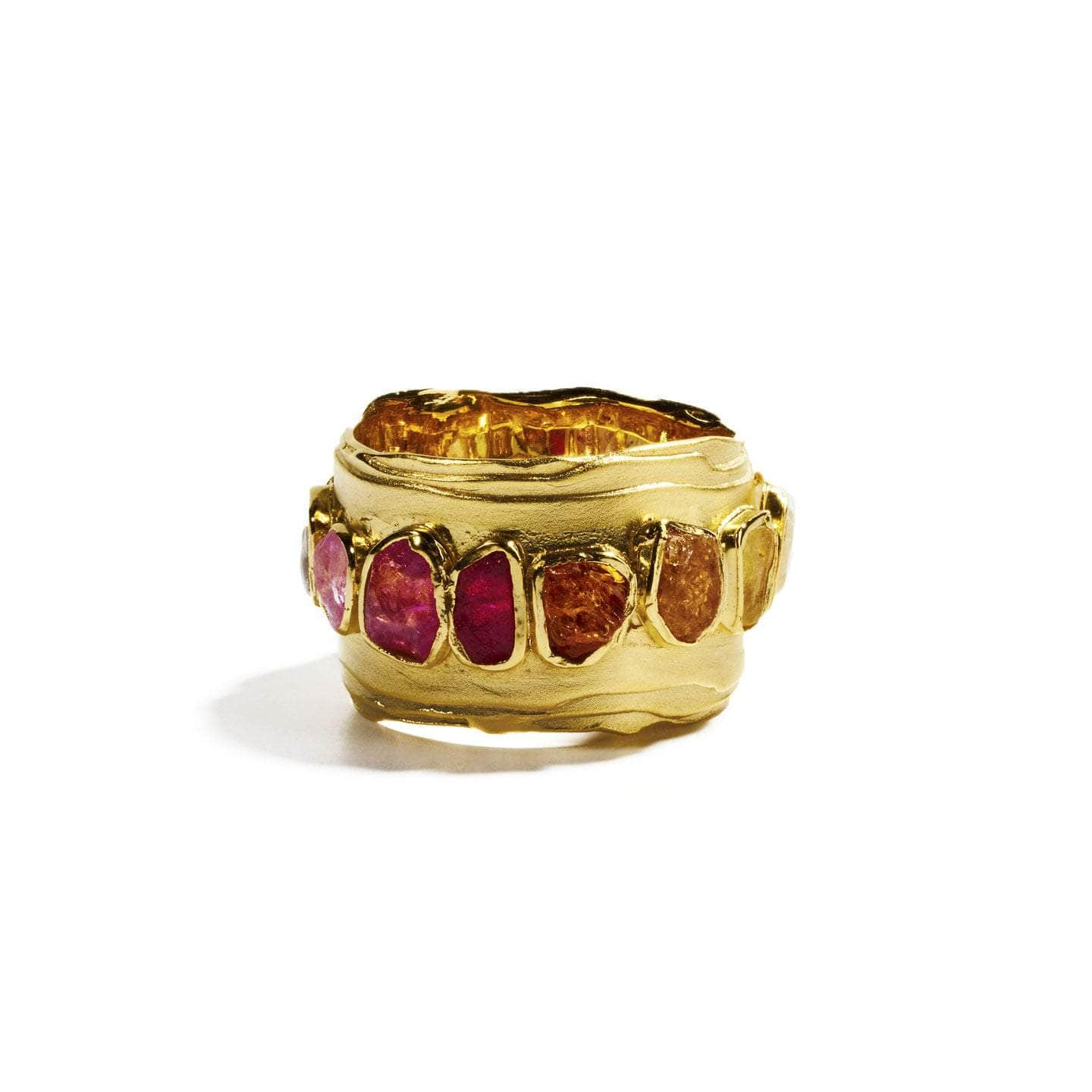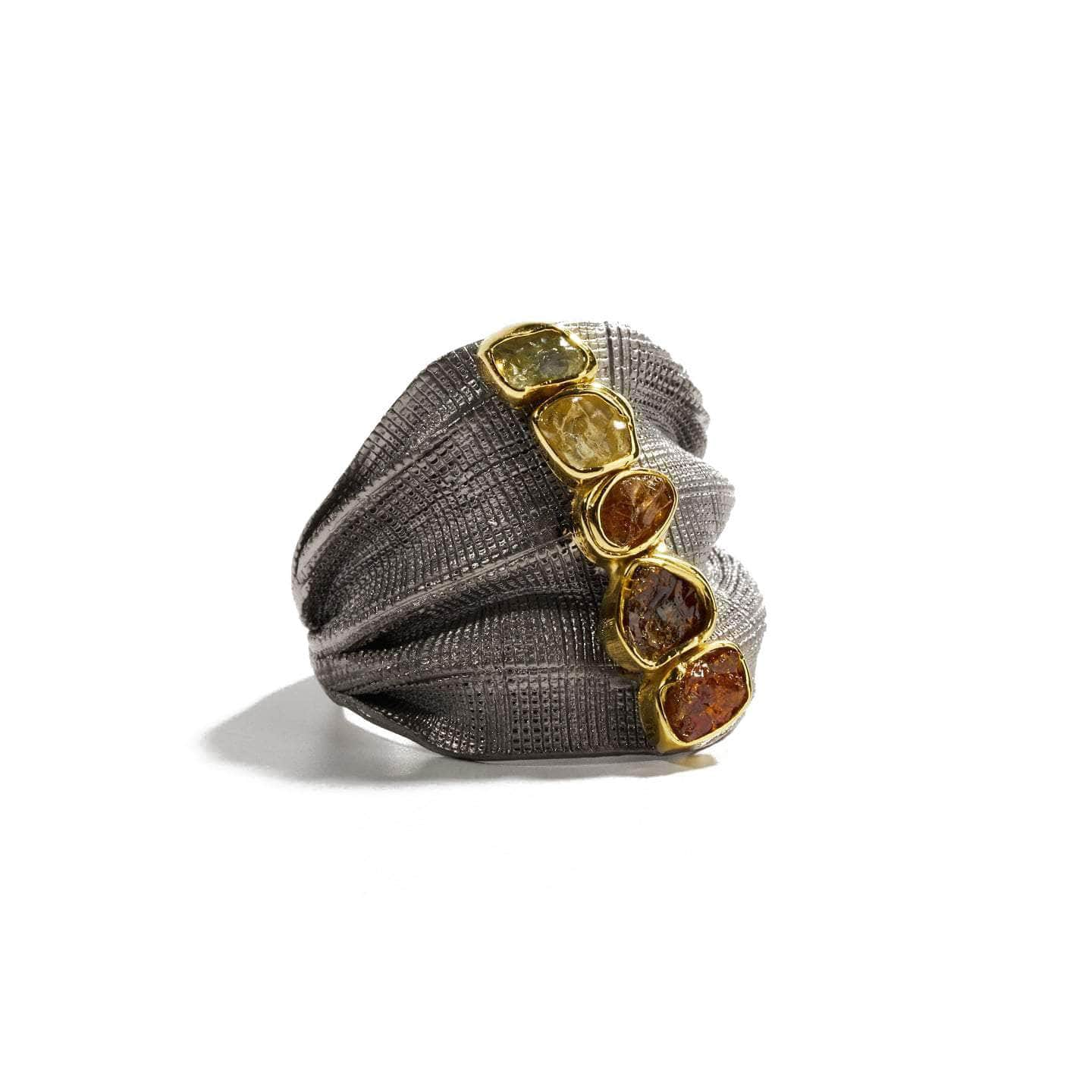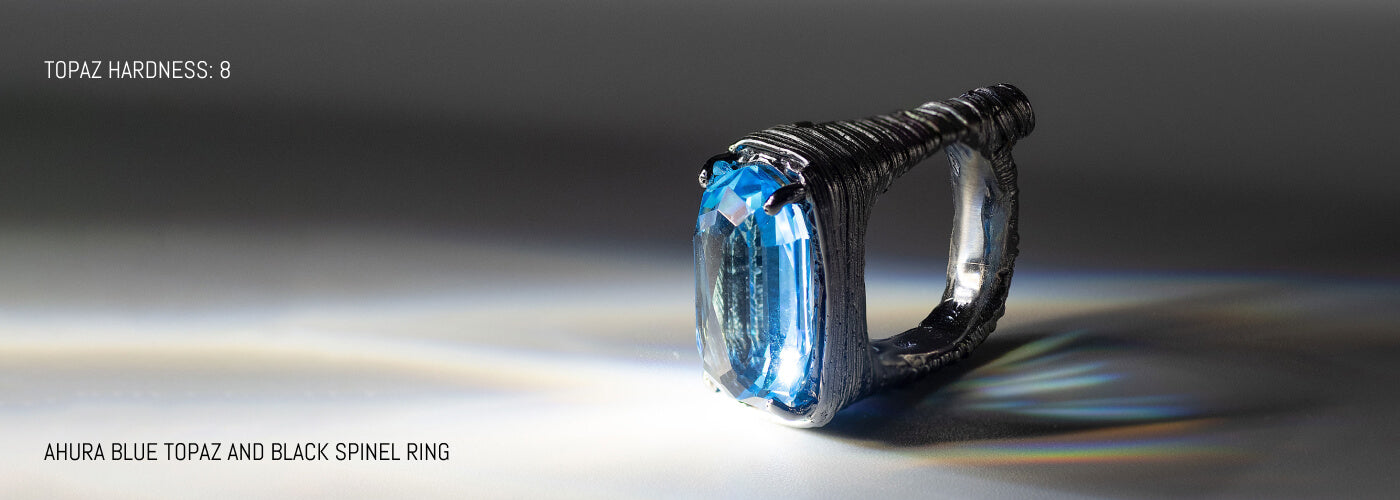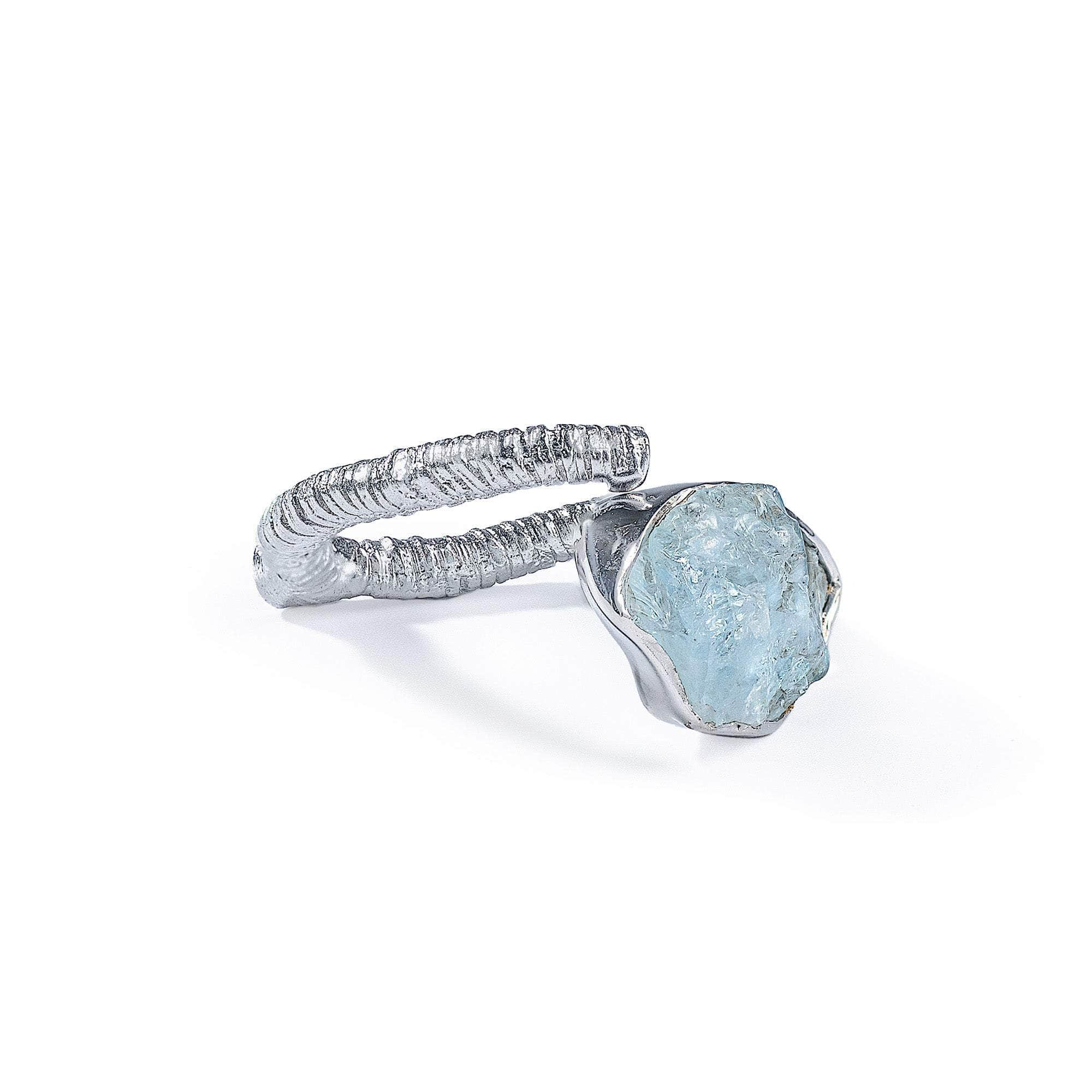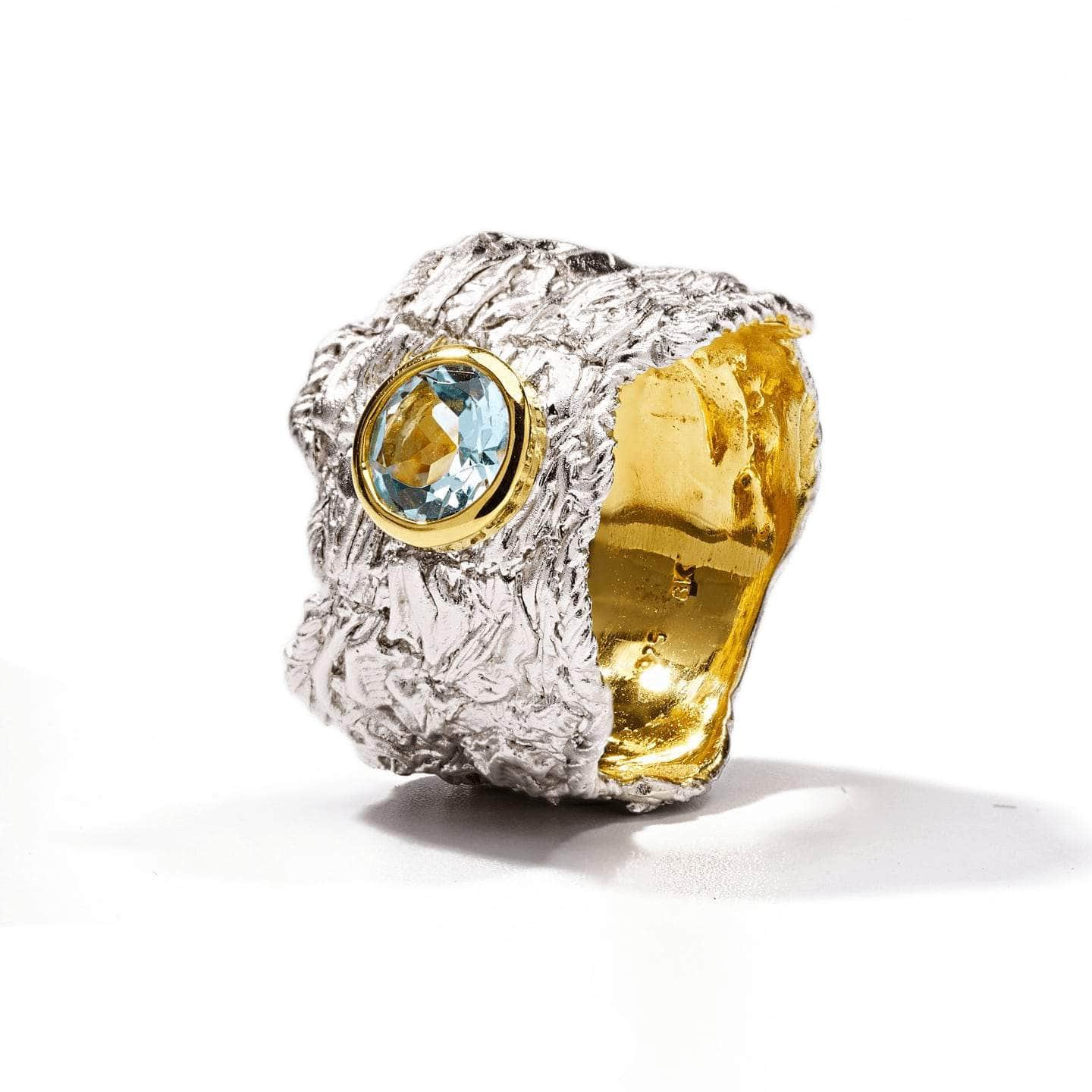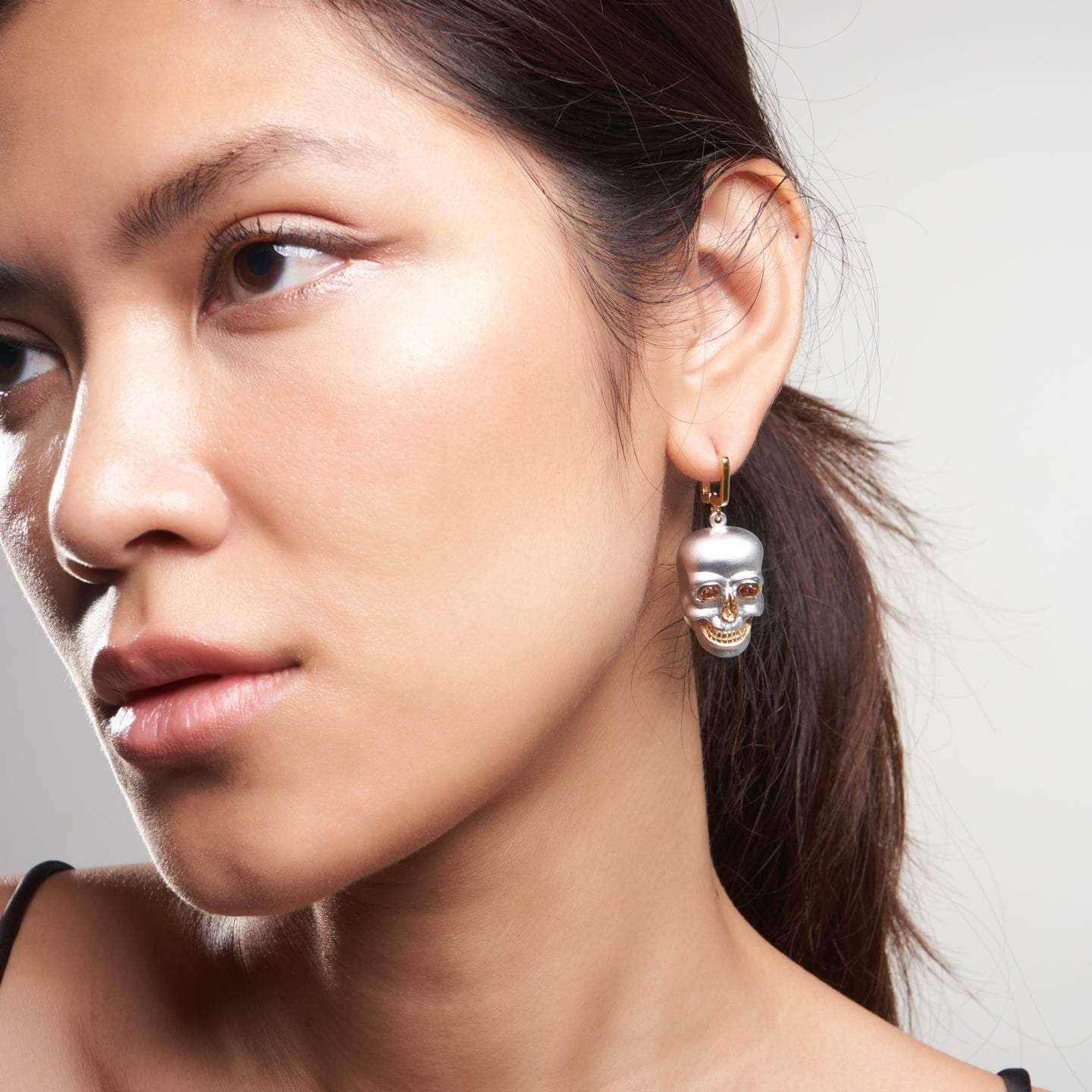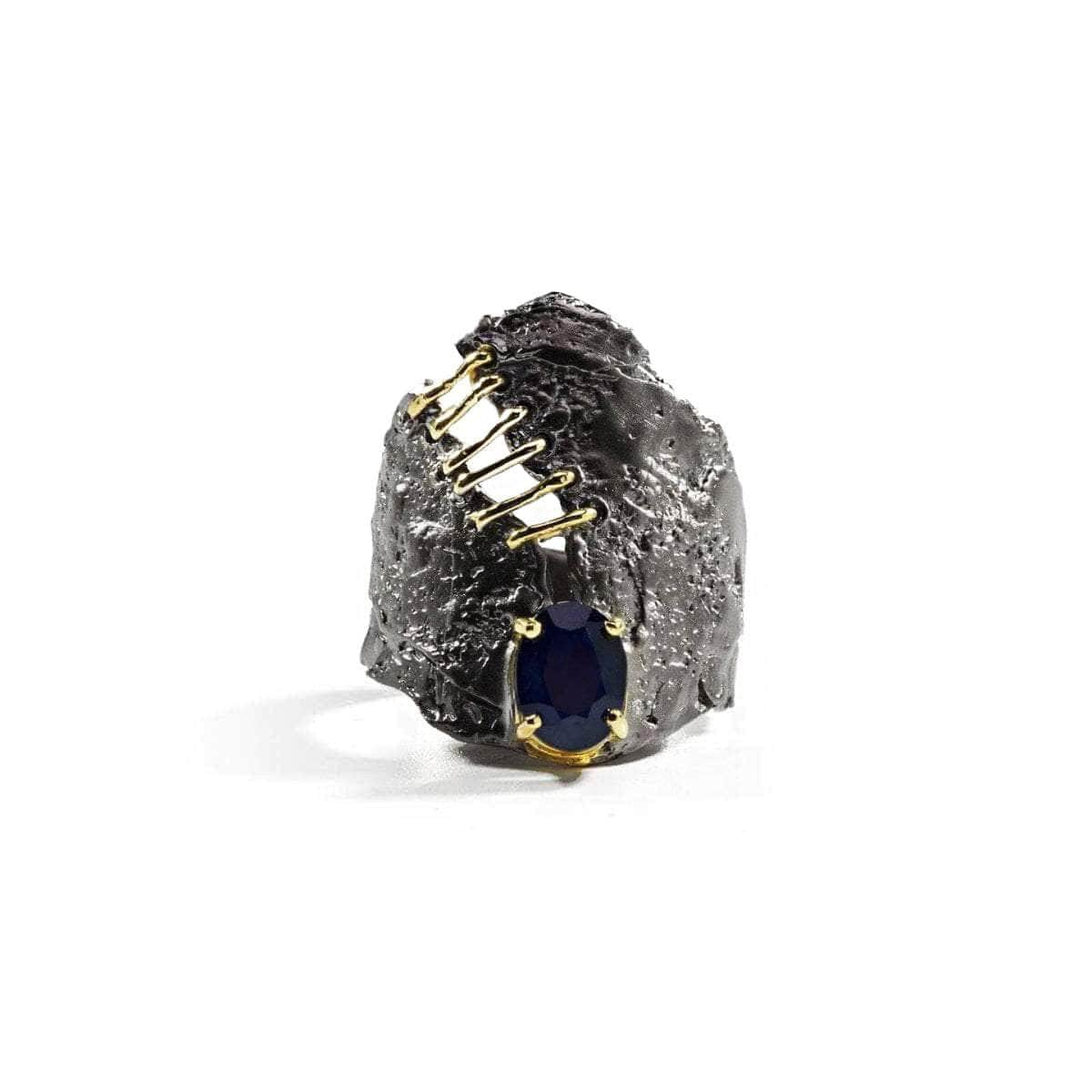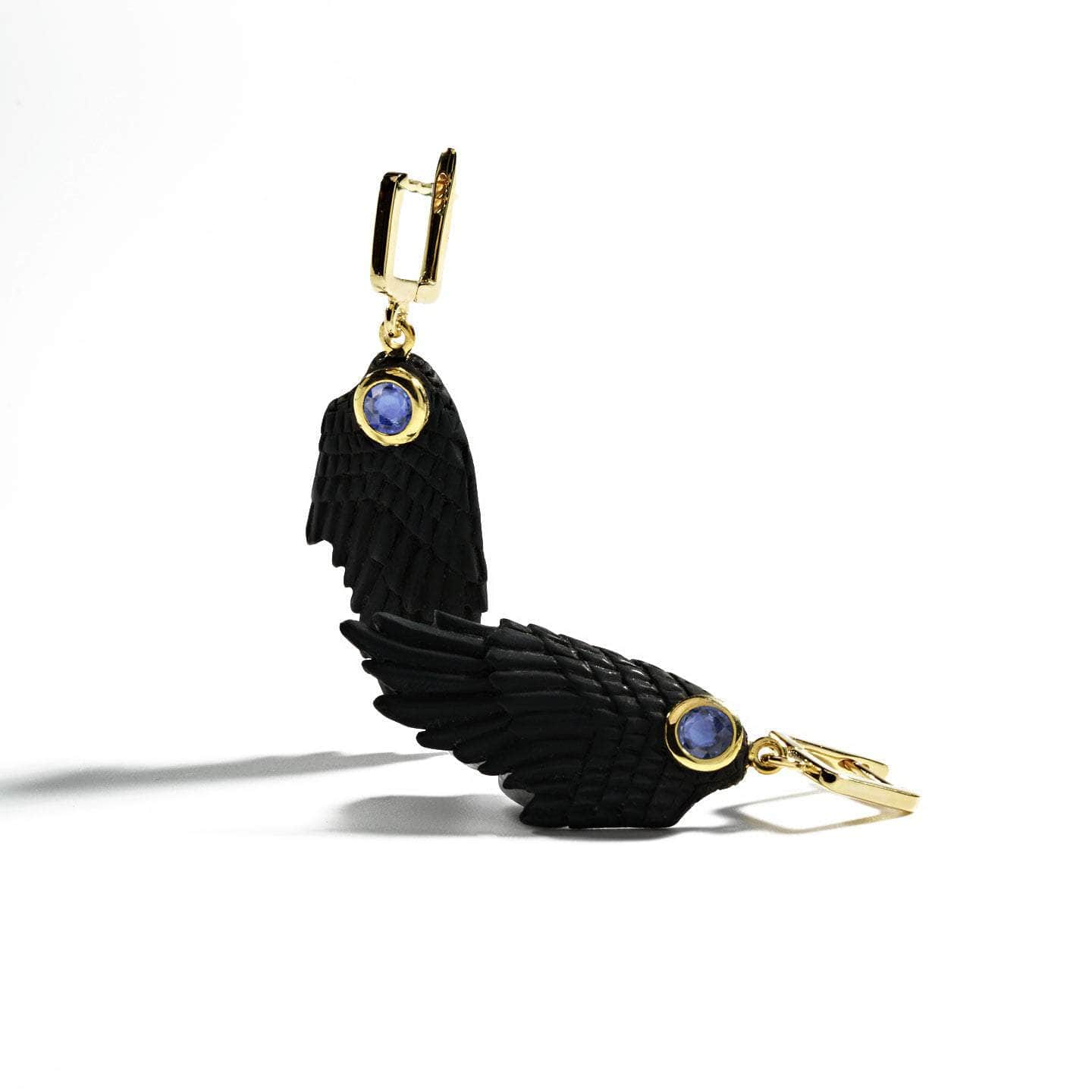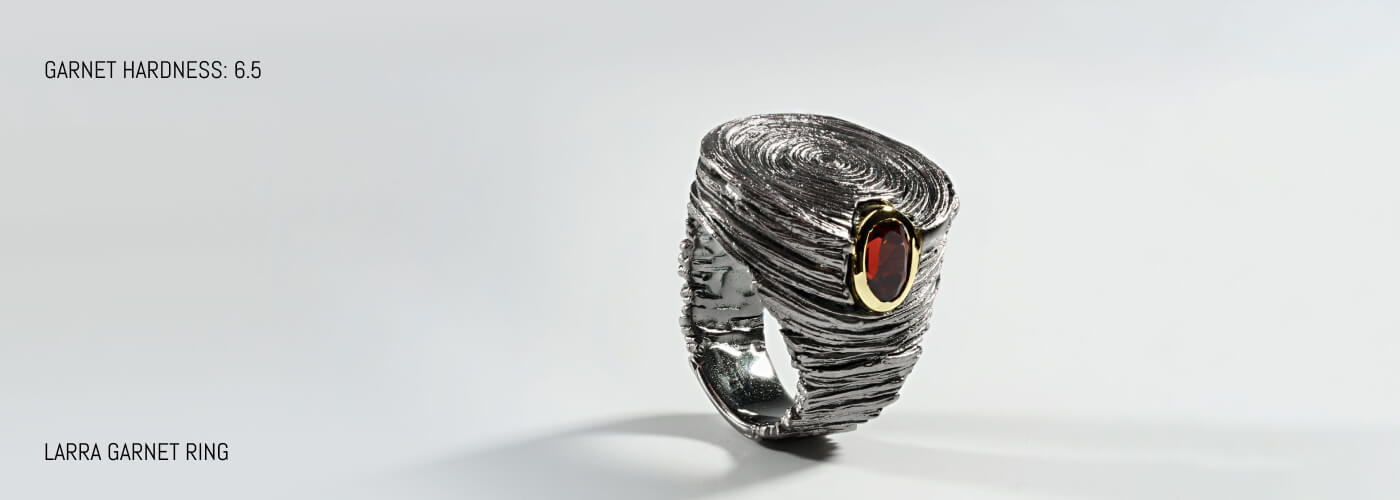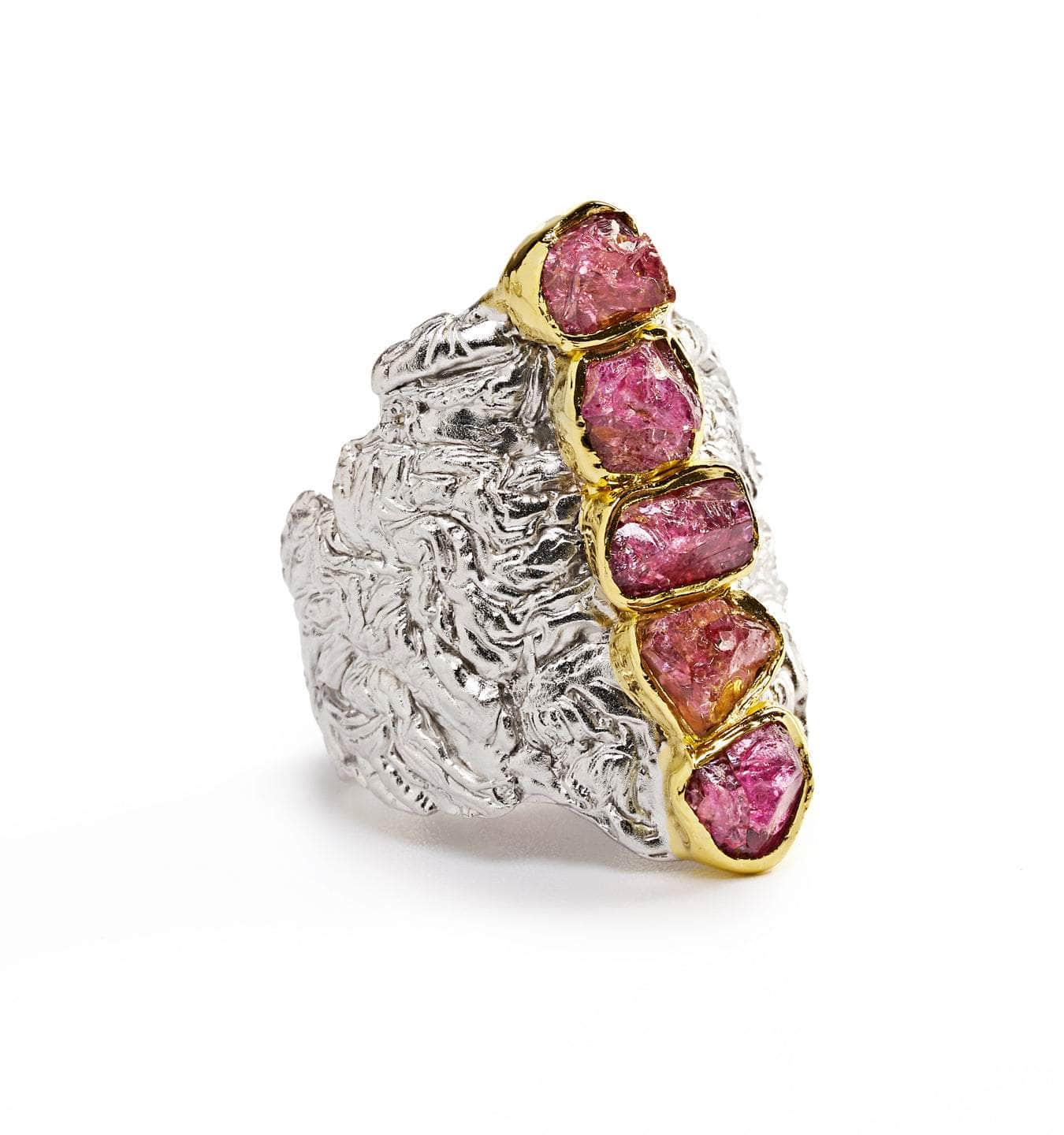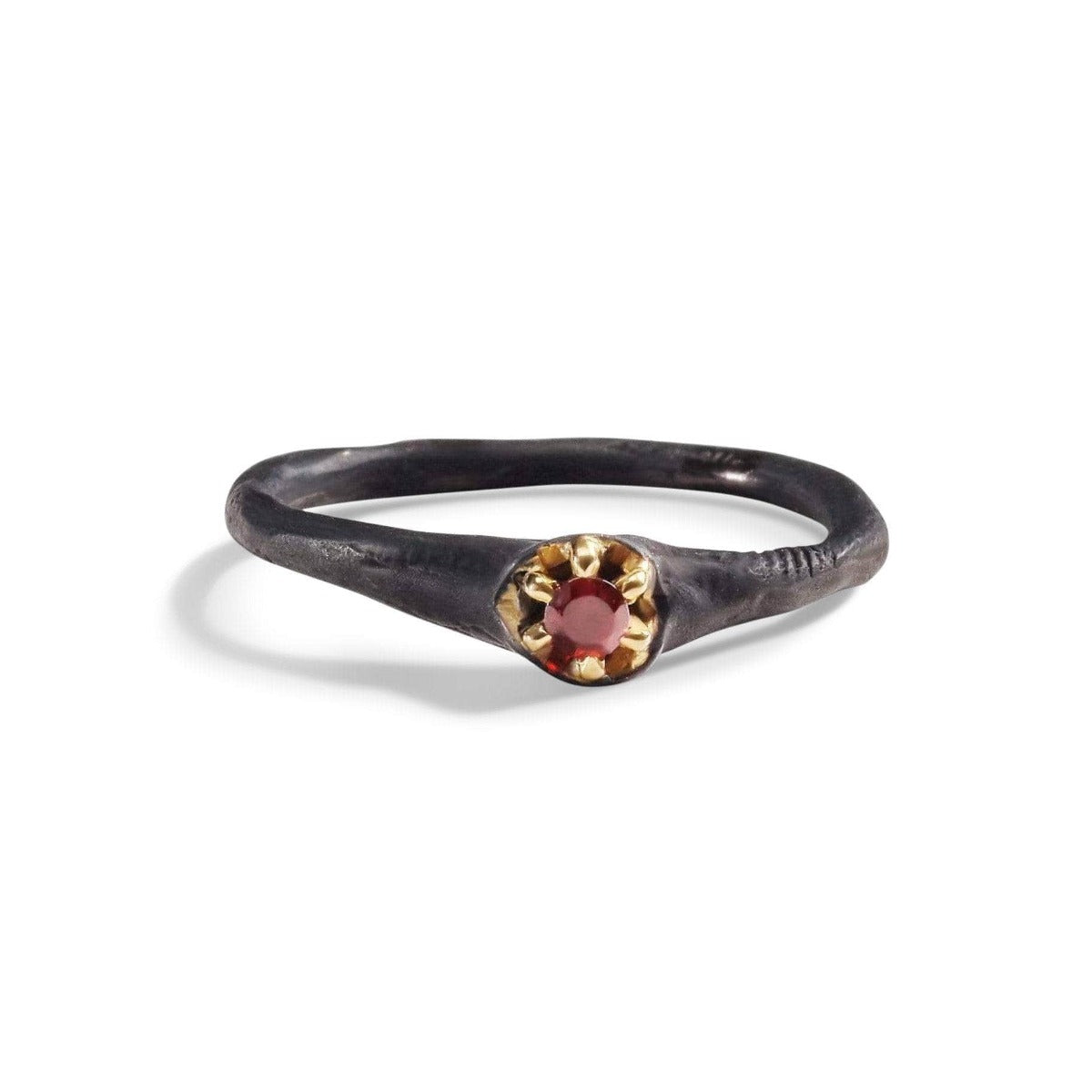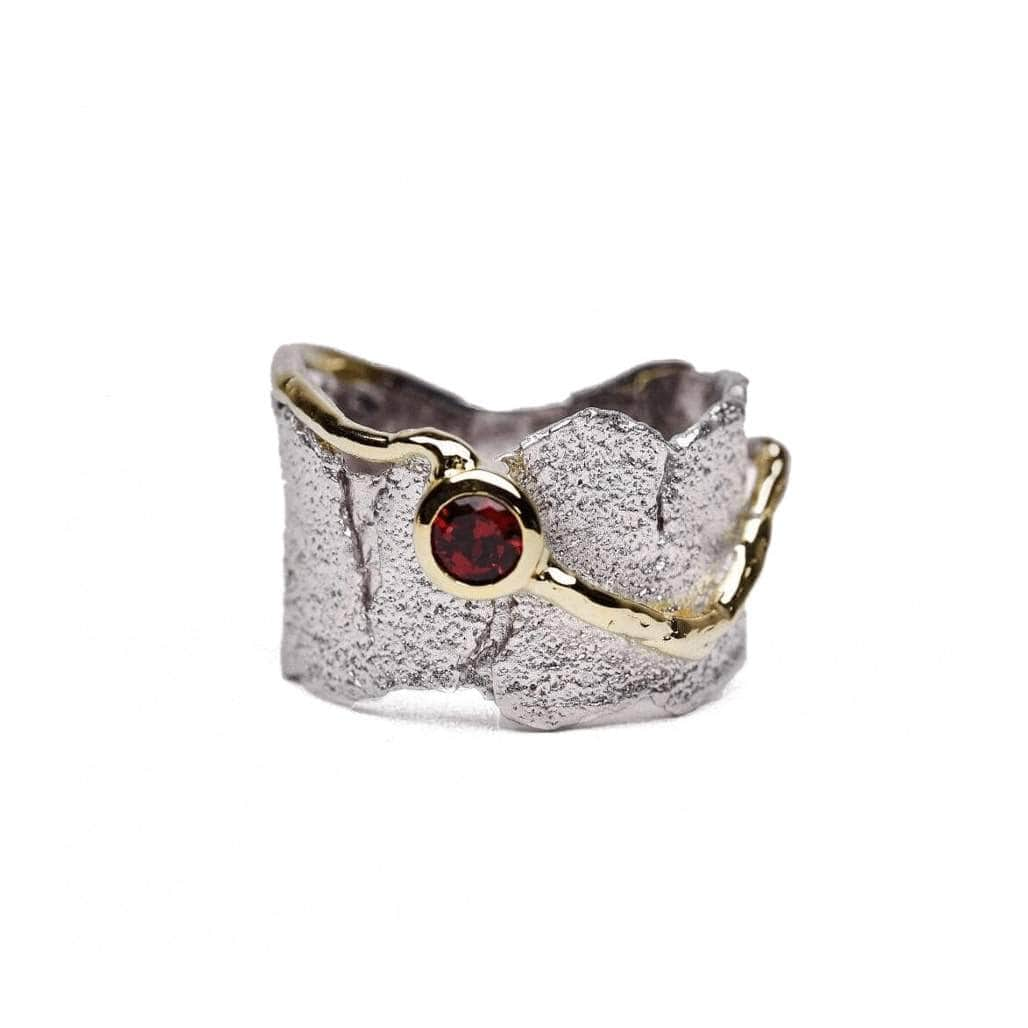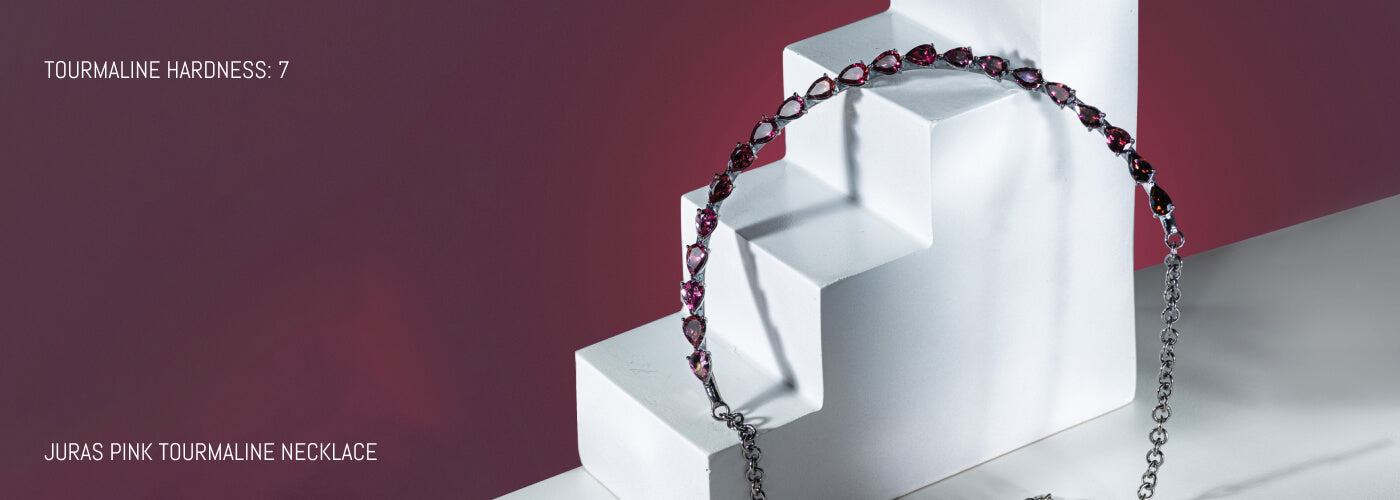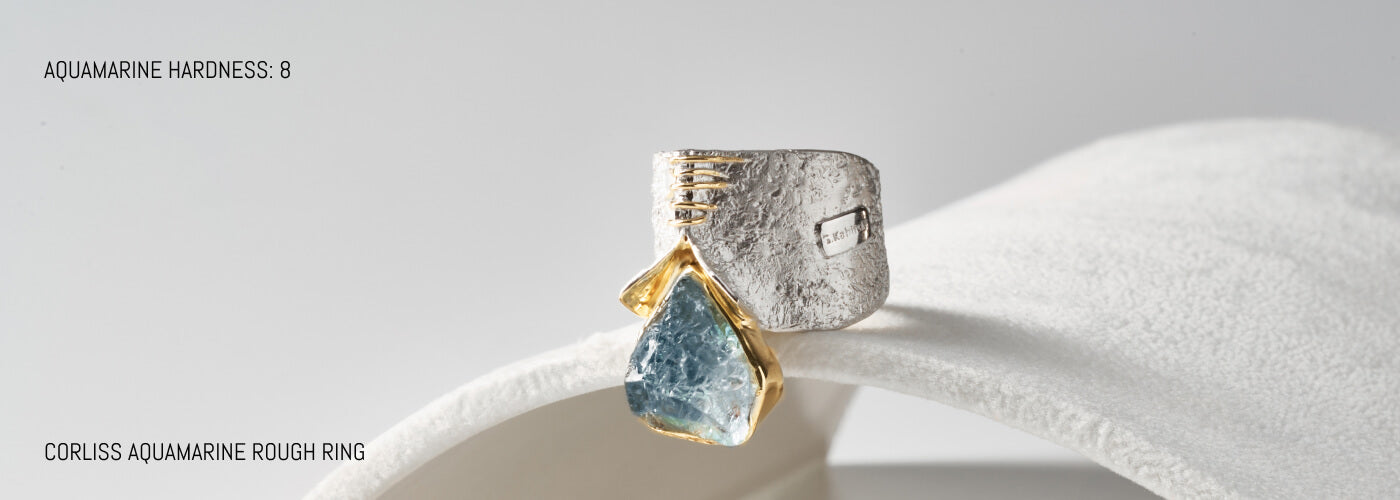Mohs Hardness Scale and Its Impact on Modern Gemstone Jewelry
How Mohs Hardness Influences Unconventional Jewelry Design

In jewelry design, the integration of natural gemstones is not just a matter of aesthetics but also a question of durability and wearability. Central to understanding this balance is the Mohs Hardness Scale, a tool that categorizes minerals based on their scratch resistance. Developed in the early 19th century by German geologist Friedrich Mohs, this scale ranges from talc, rated as the softest mineral at 1, to diamond, the hardest known material, at 10.
This guide delves deep into the Mohs Hardness Scale, analyzing its role in guiding contemporary jewelers and lovers. As we explore, we'll discover how this scale not only influences the choice of gemstones for jewelry but also drives innovation within the industry. For designers experimenting with natural gemstones, understanding the Mohs hardness is key to creating pieces that are not only visually stunning but also durable and suited for everyday wear. Let's start the journey to uncover what the Mohs Hardness Scale means for the future of jewelry design, and how it shapes the way we think about and interact with the natural gems in our favorite jewelry pieces.
What is the Mohs Scale of Hardness: From Talc to Diamond
The Mohs Scale of Hardness stands as a fundamental classification system in mineralogy, providing insight into the relative hardness of various minerals through a simple yet effective method. This scale, introduced by Friedrich Mohs in 1812, has been instrumental in both the geological and jewelry fields, offering a basic criterion for the scratch resistance of materials. Spanning from 1 to 10, the scale begins with talc, the softest mineral, and culminates with diamond, the hardest known natural material.
A Historical Overview of the Mohs Scale
The inception of the Mohs Scale was rooted in practicality. Friedrich Mohs, a German geologist and mineralogist, aimed to create a straightforward method for field geologists to identify minerals by using simple tools like a pocket knife, a glass plate, or even a copper coin. By scratching two minerals against each other, the one that scratches the other is determined to be harder. This empirical approach allowed for the quick and efficient classification of minerals on-site, revolutionizing mineralogy by providing a standard scale for hardness.
Understanding the Mohs Scale
The Mohs Scale is ingeniously simple, assigning a hardness level to ten specific minerals, each representing a point on the scale. These are: 1) Talc, 2) Gypsum, 3) Calcite, 4) Fluorite, 5) Apatite, 6) Orthoclase Feldspar, 7) Quartz, 8) Topaz, 9) Corundum, and finally, 10) Diamond. It's important to note that the scale is not linear; the difference in hardness between each successive mineral is not uniform. For instance, diamond (10) is four times harder than corundum (9), which includes rubies and sapphires.
Innovations and Educational Applications of the Mohs Scale
Beyond its immediate utility in identifying mineral hardness, the Mohs Scale has fostered educational growth and innovation within the fields of geology and mineralogy. It serves as a foundational concept in earth science education, introducing students to the tangible properties of minerals. The scale's simplicity and hands-on approach make it an ideal pedagogical tool for illustrating the diverse nature of mineral composition and durability. Moreover, the scale has inspired the development of more sophisticated methods of measuring hardness, such as the Vickers and Brinell hardness tests, which are used in industrial contexts for materials beyond minerals.
The Mohs Scale in Geological and Industrial Contexts
The practical applications of the Mohs Scale extend into geological exploration and industrial mineralogy. In geological studies, the hardness of a mineral can inform geologists about the environmental conditions during the mineral's formation. This can provide valuable insights into the history and structure of the Earth's crust. Industrially, understanding the hardness of materials is crucial for determining their suitability for various uses, such as abrasives, cutting tools, and construction materials. The relative hardness of minerals directly influences how materials are processed, shaped, and utilized in various industries.
Challenges and Limitations of the Mohs Scale
While the Mohs Scale is widely used for its simplicity and practicality, it is not without its limitations. The scale is qualitative rather than quantitative, meaning the hardness values are based on relative comparisons rather than exact measurements. This can lead to inaccuracies when assessing materials that are close in hardness or when attempting to precisely compare the hardness of two materials not directly adjacent on the scale. Furthermore, the scale does not account for other material properties such as toughness or brittleness, which can also significantly affect a material's durability and usability.
The Legacy of the Mohs Scale
Despite its limitations, the Mohs Scale remains a seminal contribution to the field of mineralogy. Its enduring relevance is a testament to Friedrich Mohs' ingenuity in creating a simple yet powerful tool for the classification of minerals. The scale has transcended its original purpose, influencing not only the field of geology but also offering a bridge to other disciplines and industries. The Mohs Scale exemplifies how foundational scientific concepts can have broad and lasting impacts, facilitating understanding, innovation, and practical application across diverse fields.
The Mohs Scale in Jewelry Design
The Mohs Scale of Hardness is an indispensable tool for jewelry designers, offering a clear and structured way to assess the suitability of various gemstones for different types of jewelry pieces. Understanding the hardness of a gemstone is crucial in determining its wearability, resistance to scratching, and overall durability, which are essential qualities for items meant to be worn daily, such as rings and bracelets. By leveraging the Mohs Scale, designers can make informed decisions, ensuring that their creations are not only beautiful but also resilient enough to stand the test of time.
Gemstones rated above 7 on the Mohs Scale are generally considered ideal for rings and other high-wear items. This includes precious stones such as diamonds (10), sapphires, and rubies (both 9), which offer exceptional durability and scratch resistance. These gemstones are often the centerpiece of choice for pieces that symbolize enduring love and commitment, thanks to their ability to retain their luster and beauty under the rigors of everyday wear. On the other hand, softer stones like lapis lazuli (5-6), opal (5.5-6.5), and turquoise (5-6) are better suited for pieces that are worn occasionally, allowing for a broader exploration of color and form while maintaining the integrity of the design. The Mohs Scale thus serves as a foundational guide, enabling designers to push the boundaries of creativity while ensuring the longevity and practicality of their creations.
Precious stones like diamonds, sapphires, and rubies, which rank at the top of the Mohs Scale, are often favored for their exceptional hardness and durability, making them ideal for engagement rings and other jewelry meant to last a lifetime. However, the scale also helps in the thoughtful selection of softer, yet equally stunning gemstones like opals and turquoise for pieces where direct wear is minimal. This informed approach enables designers to balance aesthetic desires with practical considerations, resulting in jewelry that is both beautiful and enduring.
Understanding the Mohs Scale is crucial for jewelry designers and enthusiasts alike, serving as a guide to selecting the right gemstones for various types of jewelry. The durability of a gemstone is a paramount consideration, particularly for pieces that are worn daily and exposed to potential damage, such as engagement rings and bracelets. By employing the Mohs Scale, designers can ensure the longevity and beauty of their creations, choosing stones that not only captivate the eye but also withstand the rigors of everyday wear.
Frequently Asked Questions about the Mohs Scale
In this section, we'll tackle some of the most commonly asked questions regarding the Mohs Scale of Hardness. From understanding its application in everyday life to deciphering its implications for gemstone selection, we aim to clarify these queries, making the Mohs Scale an accessible and informative tool for everyone interested in the world of minerals and gemstone jewelry.
What does the 10 Mohs scale of hardness mean?
The 10 on the Mohs scale signifies the pinnacle of mineral hardness, exclusively represented by diamonds. This rating means that a diamond can scratch any other material ranked lower on the scale, but no other natural substance can scratch a diamond. The exceptional hardness of diamonds stems from their unique structure, where each carbon atom is bonded to four other carbon atoms in a three-dimensional lattice. This not only makes diamonds the hardest natural material on Earth but also lends them remarkable durability and longevity, qualities highly sought after in various industries beyond jewelry, such as in cutting, grinding, and drilling tools.
For example, in the world of fine jewelry, a diamond's unparalleled hardness makes it the ideal choice for engagement rings and other pieces meant to be worn daily. Its ability to resist scratching and maintain its sparkle over time symbolizes enduring love and commitment. Similarly, in industrial applications, diamond-tipped tools are indispensable for their efficiency and effectiveness in cutting through hard materials like granite or reinforced concrete, showcasing the practical implications of this top Mohs scale rating.
How hard is 7 on the Mohs scale?
A 7 on the Mohs scale represents the hardness level of quartz, one of the most abundant and widely recognized minerals in the Earth's crust. This ranking indicates that quartz can scratch all other minerals with a lower ranking on the Mohs scale, such as feldspar (ranked at 6) or gypsum (ranked at 2), but it can be scratched by topaz, corundum, and diamond, which hold higher positions. Quartz's placement at 7 signifies its relatively high durability and resistance to scratching, making it a robust choice for a variety of uses.
Quartz's hardness makes it a popular choice for rings, necklaces, and other jewelry accessories that withstand everyday wear and tear better than softer minerals. Quartz comes in various forms, including amethyst, citrine, and rose quartz, offering a spectrum of colors that appeal to different tastes and styles. Beyond its aesthetic appeal, quartz's physical properties also make it valuable in various industrial and technological applications. For instance, because of its piezoelectric properties (it can generate an electric charge under mechanical stress), quartz is used in the manufacture of watches, clocks, and electronic oscillators, demonstrating the practical significance of its rating on the Mohs scale.
Is diamond the only mineral with Mohs Scale hardness 10?
Yes, within the framework of the Mohs scale, diamond is the sole mineral assigned a hardness rating of 10, distinguishing it as the hardest known natural substance. This exclusivity underscores the diamond's unparalleled ability to resist scratching by any other material, except another diamond. The Mohs scale is a comparative tool that assesses scratch resistance; thus, a diamond's top placement illustrates its supreme position in terms of durability and scratch resistance among natural materials.
The uniqueness of diamond at the pinnacle of the Mohs scale has profound implications beyond just its symbolic status in jewelry. It plays a crucial role in various industrial applications where extreme hardness is required. For instance, diamond-tipped drill bits and saw blades are invaluable in mining and construction, capable of cutting through highly durable materials with precision and efficiency. Additionally, the scientific and technological sectors leverage the exceptional hardness of diamonds in specialized equipment, such as in the production of precision cutting tools for delicate electronic components, showcasing the wide-ranging utility of diamonds that stems from their unmatched position on the Mohs scale.
How hard is ruby?
Rubies, renowned for their striking red hue, are allocated a hardness of 9 on the Mohs scale, making them one of the hardest natural gemstones known to man. This rating places them directly beneath diamonds, which are at the pinnacle of the scale with a rating of 10. The significant hardness of rubies not only highlights their durability but also their suitability for a wide array of jewelry applications, especially those that are subject to daily wear and tear, such as rings and bracelets.
The hardness of a ruby is a testament to its resilience, enabling it to maintain its luster and resist scratches from materials of a lower hardness rating. This quality ensures that rubies retain their breathtaking beauty over years of wear, symbolizing not just love and passion but also the enduring strength of the bond it represents. It is this combination of aesthetic appeal and physical durability that makes rubies a highly coveted choice for fine jewelry, representing both luxury and lasting value.
Furthermore, the robustness of rubies extends their use beyond ornamental purposes. Their hardness and resistance to wear make them valuable in industrial applications, such as in watchmaking for bearing components, and in laser technology for producing coherent light. Thus, the Mohs scale rating of 9 for rubies underscores their versatility and enduring nature, securing their place both in the hearts of jewelry lovers and in the precision of technological innovations.
What is the softest material on the Mohs Scale?
The softest mineral known to science is talc, which occupies the very first position on the Mohs scale of hardness with a rating of 1. This mineral is characterized by its greasy feel and ability to be scratched easily with a fingernail. Talc's softness is due to its layered structure, which allows the layers to slide over each other with minimal force. This unique physical property not only defines talc's position on the Mohs scale but also underpins its widespread use in various applications, ranging from cosmetic products to industrial lubricants.
In everyday life, talc is most familiar as the primary ingredient in talcum powder, which is used for its moisture-absorbing and friction-reducing properties. Beyond personal care, talc's softness and lubricity make it valuable in the manufacturing of ceramics, paint, paper, and even food processing. Its role in reducing stickiness and providing a smooth texture extends talc's utility far beyond what its simple ranking on the Mohs scale might suggest, showcasing the diverse applications of even the softest mineral.
How Hard is Topaz, One of German Kabirski's Most Used Gemstones?
Topaz holds a prestigious position on the Mohs scale of hardness with a rating of 8, making it one of the harder gemstones available. This level of hardness implies that topaz is quite durable and resistant to scratches from substances with a lower hardness rating. The robust nature of topaz, coupled with its vibrant array of colors—from clear, through yellow, orange, pink, and blue—makes it a favored choice for jewelers and designers looking for both beauty and resilience in their creations. German Kabirski, a renowned jewelry designer known for his avant-garde and unique approach to jewelry making, frequently incorporates topaz into his designs, leveraging its hardness and aesthetic versatility to create pieces that are not only visually striking but also durable.
Beyond its hardness, topaz exhibits other gemological characteristics that enhance its appeal. It has a high refractive index, which contributes to its brilliant sparkle, and it often forms in large, flawless crystals, allowing for the creation of substantial gemstone pieces without the inclusion of imperfections. Topaz is also pleochroic, meaning it can show different colors or intensities of color when viewed from different angles. This adds a layer of complexity and allure to the gemstone, making it a fascinating choice for jewelry designers like German Kabirski, who is celebrated for his innovative and thought-provoking designs. The combination of topaz's physical durability, optical beauty, and the creative application by designers such as Kabirski underscores the gemstone's significance in contemporary jewelry design.
How hard is a sapphire, German Kabirski #1 Gemstone?
Sapphire, celebrated for its exceptional hardness and breathtaking hues, boasts a Mohs scale rating of 9, making it the second hardest natural gemstone after diamond. This remarkable hardness endows sapphires with outstanding durability and resistance to scratches, ensuring that jewelry crafted with sapphires can withstand the rigors of daily wear while maintaining its captivating beauty. German Kabirski, a visionary in the world of jewelry design, often chooses sapphire as his gemstone of choice, not only for its physical robustness but also for its vibrant color spectrum, which ranges from the classic deep blue to pink, yellow, and even green. The versatility and strength of sapphire align perfectly with Kabirski’s innovative design ethos, enabling the creation of avant-garde pieces that push the boundaries of traditional jewelry.
Beyond their hardness, sapphires (alongside rubies, which are corundum's red variety) exhibit excellent gemological properties such as high thermal stability and resistance to chemical attacks, making them ideal candidates for experimental jewelry design techniques. One notable method involves casting gemstones directly within molten metal, a process that many gemstones cannot withstand due to their lower melting points and susceptibility to thermal shock. However, the resilience of sapphires and rubies to high temperatures allows for their incorporation into metal casts without damage, opening up new avenues for creative expression in jewelry design. This capability is particularly valued by designers like German Kabirski, who is renowned for his unconventional approach and willingness to explore the limits of materials and design. The ability to cast sapphires directly with metals enables the creation of unique, one-of-a-kind pieces that defy traditional jewelry making conventions, showcasing the gemstone's unparalleled beauty and the designer's creative vision.
What Gemstones Are Harder Than Quartz on Mohs Scale?
Beyond quartz, which is ranked at a hardness of 7 on the Mohs scale, there exists a select group of minerals and gemstones that exhibit greater resistance to scratching and wear. Notable among these are topaz, corundum (which includes sapphires and rubies), and diamond, with hardness ratings of 8, 9, and 10 respectively. This increased hardness makes them less susceptible to damage and more suitable for applications requiring durability and longevity. Topaz, with its rating of 8, offers greater scratch resistance than quartz, making it a preferred choice for jewelry that can withstand more rigorous wear. Meanwhile, sapphires and rubies (corundum) at 9, and diamonds at the pinnacle of 10, are significantly harder, offering the highest levels of durability and scratch resistance in the natural gemstone world.
These harder gemstones are not only valued for their durability but also for their beauty and rarity, which make them highly sought after for high-quality jewelry. The exceptional hardness of sapphires and rubies also allows them to withstand high temperatures, enabling jewelry designers to employ them in innovative ways, such as casting gemstones directly into metal, a technique that opens up new realms of design possibilities. This method facilitates the creation of unique, unconventional pieces that challenge traditional jewelry-making conventions.
German Kabirski, an anarchist designer, embraces the natural beauty and inherent energy of gemstones by often choosing to work with them in their raw, uncut forms. His preference for raw, untouched gemstones is not merely an aesthetic choice but a philosophical one, grounded in the belief that gemstones in their natural state retain more of their original energy and character. Kabirski's advanced techniques and inventions for setting these raw gemstones into jewelry are unparalleled, marking him as a pioneer among designers who dare to explore the untouched beauty of the natural world. This approach not only highlights the inherent beauty and energy of the gemstones but also showcases Kabirski's commitment to innovation and creativity in jewelry design.
What is the Hardness of Garnet on the Moh's Scale?
Garnet, a gemstone celebrated for its rich palette and versatility, registers between 6.5 and 7.5 on the Mohs scale of hardness. This range places garnet in the upper-middle tier of mineral hardness, suggesting that it possesses good durability and resistance to everyday wear and tear. The hardness of garnet can vary slightly among its different varieties, but generally, it is considered hard enough to be used in all types of jewelry, including rings, pendants, and earrings, which are subject to frequent contact.
The diversity of garnet is notable, encompassing a spectrum of colors from the deep reds of almandine and pyrope to the vibrant greens of tsavorite and demantoid. This broad array of hues not only makes garnet highly desirable for its aesthetic qualities but also offers designers a wide range of creative possibilities. Each type of garnet brings its unique shade and character to jewelry pieces, enabling designers to tailor their creations to suit individual preferences and styles.
German Kabirski, in particular, has a well-known affinity for garnets, utilizing them extensively in both their polished and natural, unrefined states. His appreciation for the gemstone's diverse color range is evident in his innovative jewelry pieces that feature raw tsavorite, spessartine, and rhodolite garnets, among others. Kabirski's approach to jewelry design, which often involves the use of garnets in casting processes, allows for the creation of groundbreaking designs that challenge conventional jewelry norms. By incorporating garnets into his pieces, Kabirski not only showcases the stone's natural beauty but also its versatility in crafting novel and unconventional designs. For jewelry designers looking to experiment with casting and setting techniques, garnets offer a fantastic medium to explore new and exciting design frontiers, blending traditional elegance with contemporary innovation.
How Hard is Tourmaline on the Mohs Scale?
Tourmaline, a gemstone celebrated for its vast spectrum of colors, registers a hardness of 7 to 7.5 on the Mohs scale. This rating places it in the realm of relatively hard gemstones, capable of resisting scratches from substances with a lower hardness rating. The resilience of tourmaline makes it a favored choice for a variety of jewelry pieces, as it can endure the rigors of daily wear while maintaining its lustrous beauty. The hardness of tourmaline is just one facet of its appeal; the gemstone is also known for its remarkable pleochroism, displaying different colors or intensities of colors when viewed from different angles, enhancing its allure and uniqueness.
Tourmaline's broad color range is another one of its defining characteristics, encompassing virtually every hue from colorless to black, including pastel shades of pink, peach, green, and vibrant electric blues. This diversity is due to trace elements such as iron, manganese, and chromium, which influence the gemstone's coloration. Additionally, tourmaline can exhibit a captivating effect known as chatoyancy or the cat's eye effect, and some varieties can even change color under different lighting conditions. These gemological characteristics make tourmaline a versatile and highly sought-after gemstone for both collectors and jewelry designers, offering endless possibilities for creative expression.
The gemstone's piezoelectric and pyroelectric properties, where it can become electrically charged through heat or pressure, add another layer of fascination to tourmaline. This feature has been explored in various technological applications, from pressure gauges to generating electric charges. In the realm of jewelry, however, it's the combination of tourmaline's hardness, color diversity, and unique optical properties that truly sets it apart, making it a cherished material for crafting exquisite and durable pieces.
Is Aquamarine Hard on the Mohs Scale?
Aquamarine, a beloved gemstone known for its tranquil, sea-blue hues, registers a hardness of 7.5 to 8 on the Mohs scale. This indicates a good level of durability and resistance to scratches, making aquamarine suitable for a variety of jewelry applications, including those intended for daily wear. Its hardness, coupled with its water-clear clarity and delicate color, has made aquamarine a favorite among jewelers and wearers alike. The gemstone belongs to the beryl family, which also includes emerald and morganite, and shares the same desirable qualities of hardness and beauty, albeit with its distinct calming blue to greenish-blue coloration that captures the essence of ocean waters.
In addition to its pleasing aesthetic and respectable hardness, aquamarine is valued for its excellent clarity and can be found in large sizes, making it ideal for statement pieces and fine jewelry. The gemstone also possesses a vitreous luster that enhances its aquatic appearance, creating a captivating glow that is both elegant and timeless. Its versatility in cut and shape allows designers to explore creative expressions, from classic faceted styles that highlight the stone's clarity and sparkle to more organic, rough-cut forms that emphasize its natural beauty.
Renowned jewelry designer German Kabirski, in particular, exhibits a fondness for aquamarine in its raw, naturally shaped form. Kabirski's innovative approach to jewelry design often incorporates aquamarine's unspoiled beauty, utilizing both its translucent sea-blue shades and its natural shapes to craft pieces that resonate with raw elegance and uniqueness. This preference for the gemstone's natural form not only showcases Kabirski's artistic vision but also highlights the inherent allure of aquamarine, making his creations standout examples of how contemporary designers can harness the gemological characteristics of aquamarine to push the boundaries of traditional jewelry design.
How the Mohs Scale Helps Modern Jewelry Designers
The Mohs Scale of Hardness is not just a tool for gemologists and mineralogists; it's a critical resource for modern jewelry designers, offering a foundation for experimentation and innovation. Understanding the hardness of various gemstones allows designers to push the boundaries of traditional jewelry, incorporating materials in novel ways that were previously unexplored due to limitations in durability and wearability. This knowledge equips designers with the confidence to experiment with unconventional materials and methods, leading to revolutionary designs that challenge and expand the conventional aesthetic of jewelry.
For instance, the ability to discern which gemstones can withstand the rigors of daily wear versus those that are better suited for occasional wear enables designers to make informed choices about which stones to incorporate into their pieces. This is particularly important for those who are venturing into the realm of avant-garde jewelry, where the material's physical properties become as integral to the design as its aesthetic appeal. Designers like German Kabirski leverage this information to select gemstones that not only contribute to the visual impact of a piece but also ensure its longevity and durability.
Moreover, the Mohs Scale informs designers about which gemstones can endure the high temperatures of metal casting processes, allowing for the creation of innovative pieces where the gemstones are integrated directly into molten metal. This technique, which blurs the lines between the gemstone and its setting, results in unique, seamless pieces that traditional setters might find too risky or impossible to attempt. Armed with the knowledge of the Mohs Scale, modern jewelry designers are redefining the possibilities within their craft, combining artistry with science to explore new frontiers in jewelry design.
How the Mohs Scale Benefits Jewelry Lovers
For jewelry lovers, the Mohs Scale of Hardness is an invaluable guide to understanding the durability and care requirements of their beloved pieces. By familiarizing themselves with the hardness of various gemstones, enthusiasts can make informed decisions about which items are suitable for everyday wear and which ones should be reserved for special occasions to avoid damage. This knowledge not only extends the life of their jewelry but also ensures that each piece retains its beauty and value over time.
The scale helps delineate which gemstones can withstand the daily exposure to potential scratches and impacts. For instance, diamonds, sapphires, and rubies, with their top ratings on the Mohs Scale, are ideal for engagement rings and other jewelry meant to be worn daily. On the other hand, softer minerals like opal or pearl require more careful handling and are better suited for earrings or necklaces that are less likely to encounter rough surfaces.
Furthermore, jewelry enthusiasts can use this information to better care for their collections. Understanding the relative hardness of gemstones can guide proper storage practices—such as keeping harder gemstones separate from softer ones to prevent scratches—and inform the best cleaning methods to maintain each piece's luster without causing harm. Ultimately, the Mohs Scale empowers jewelry lovers to cherish and maintain their collections with the reverence and care they deserve, ensuring each piece can be enjoyed for generations to come.
